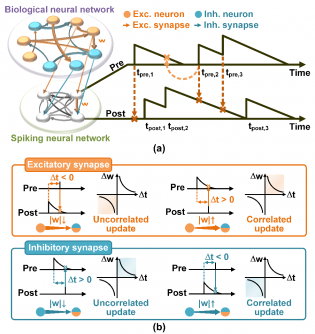Science
KIST Researchers Develop Real-Time Brain Connectivity Chip

Researchers at the Korea Institute of Science and Technology (KIST) have unveiled a groundbreaking chip that interprets brain neural connectivity in real-time. This innovation is poised to enhance brain-computer interface (BCI) technologies, which are crucial for applications such as controlling artificial limbs and improving human cognitive abilities.
The team, led by Dr. Jongkil Park, developed a novel approach that emulates the brain’s learning mechanisms. They engineered a technique based on spike-timing-dependent plasticity (STDP), allowing the chip to adjust connection strengths between neurons based on the timing of their signals. This method enables real-time analysis of neural networks without the need to store extensive data from all neurons, a significant advancement from traditional methods.
Revolutionizing Neural Network Analysis
Conventional techniques require lengthy data storage and complex statistical analysis, which can delay processing as neural networks grow larger. The new learning algorithm introduced by the KIST team drastically reduces the memory needed for hardware implementation of STDP. By removing the resource-intensive ‘reverse lookup table,’ the researchers have created a scalable structure that can be integrated into advanced neuromorphic hardware.
This innovative system achieves processing speeds up to 20,000 times faster than existing methods while maintaining similar accuracy levels. This leap in speed and efficiency is critical, especially in contexts where numerous signals are processed simultaneously, such as in brain activity.
Neuromorphic engineering represents a new frontier in artificial intelligence, mimicking the brain’s neural structure to replicate human cognition. This area has garnered significant interest from industrialized nations, including the United States and countries in Europe, all seeking to establish their technological leadership.
Commercial Viability and Future Applications
Despite its promise, commercialization of neuromorphic technology has faced challenges, primarily due to the absence of a defining application that can demonstrate its utility effectively. The recent advancements in real-time neural connectivity analysis by KIST represent a significant step toward practical applications of neuromorphic engineering.
“This achievement marks an important turning point in the evolution of neuromorphic computing into a powerful tool for solving real-world problems,” said Dr. Park. “With its simple hardware structure and easy scalability, it can be applied to advanced AI fields such as autonomous vehicles and satellite communications by controlling devices with just a thought.”
The implications of this research are vast. The technology could facilitate the analysis of complex sensor signals in real time, where understanding time sequences and cause-and-effect relationships is crucial. As KIST continues to push boundaries, it stands as a pivotal player in the future of next-generation AI semiconductors.
KIST, established in 1966 as Korea’s first government-funded research institute, remains committed to addressing national and societal challenges through innovative research. This latest study has received support from the Ministry of Science and ICT and the National Research Foundation of Korea.
The findings from this research were published in the March 2024 issue of the IEEE Transactions on Neural Systems and Rehabilitation Engineering, further solidifying its relevance in the field of neuroscience and technology.
-

 Technology4 months ago
Technology4 months agoDiscover the Top 10 Calorie Counting Apps of 2025
-

 Health2 months ago
Health2 months agoBella Hadid Shares Health Update After Treatment for Lyme Disease
-

 Health3 months ago
Health3 months agoErin Bates Shares Recovery Update Following Sepsis Complications
-

 Technology3 weeks ago
Technology3 weeks agoDiscover 2025’s Top GPUs for Exceptional 4K Gaming Performance
-

 Technology4 months ago
Technology4 months agoDiscover How to Reverse Image Search Using ChatGPT Effortlessly
-

 Technology2 months ago
Technology2 months agoElectric Moto Influencer Surronster Arrested in Tijuana
-

 Technology4 months ago
Technology4 months agoMeta Initiates $60B AI Data Center Expansion, Starting in Ohio
-

 Technology4 months ago
Technology4 months agoRecovering a Suspended TikTok Account: A Step-by-Step Guide
-

 Health4 months ago
Health4 months agoTested: Rab Firewall Mountain Jacket Survives Harsh Conditions
-

 Lifestyle4 months ago
Lifestyle4 months agoBelton Family Reunites After Daughter Survives Hill Country Floods
-

 Technology3 months ago
Technology3 months agoUncovering the Top Five Most Challenging Motorcycles to Ride
-

 Technology4 weeks ago
Technology4 weeks agoDiscover the Best Wireless Earbuds for Every Lifestyle









